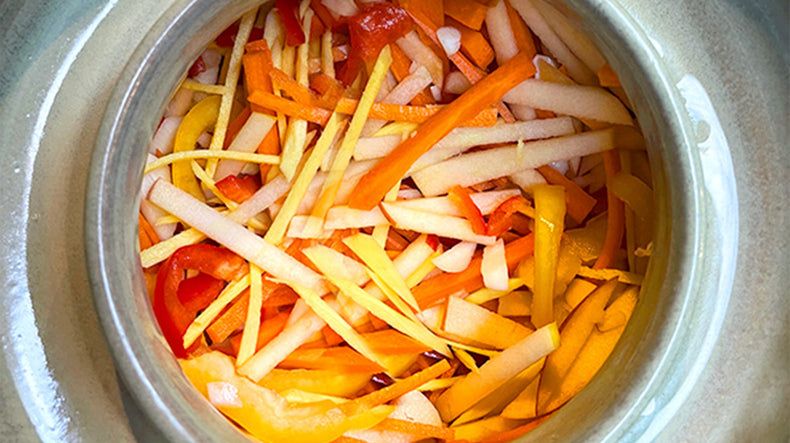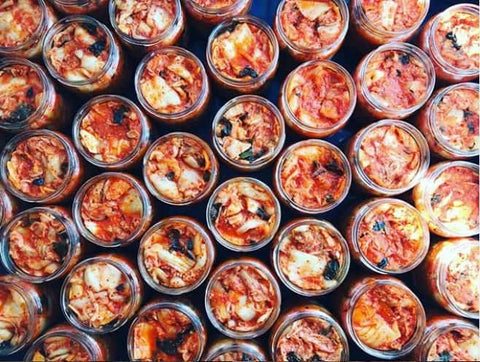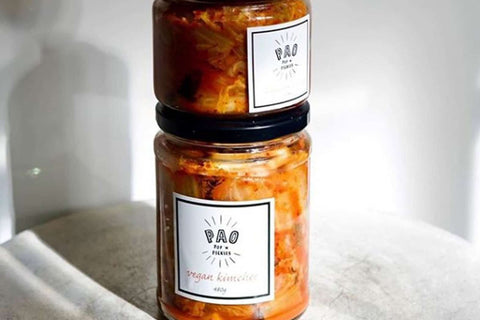A Beginners Guide to Fermenting

Fermenting food is an exciting way to develop new flavours, and experiment with different ingredients at home. Plus, there are many suggested health benefits. Pao Liu, founder of Pao Pop ‘N Pickles talks us through the science of fermenting, and explains how to start fermenting at home.
You might also enjoy how to choose the right fermentation pot and what do you need to start fermenting at home.
How did you start fermenting?
“I come from Taiwan. Fermented food is everywhere over there, from pao cai (fermented cabbage) to stinky tofu – you find it in high end restaurants and in street food. I adore the flavours! I have a clear memory of fermenting at home with my grandfather. We packed some cabbage, garlic, ginger and chilli into a jar with salt, boiled and cooled water, and a splash of rice wine. I still remember seeing the bubbles forming and seeing the brine turn cloudy. And the amazing smell when we opened the jar.
Fast forward 30 years to when I have a family of my own in London. I began to be concerned about what is in the jars of fermented food I bought in shops – I didn’t like the chemical preservatives listed on ingredient lists. So I started making my own fermented food and there was no turning back. Now I make kimchi, sauerkraut, kvass, milk kefir, miso, fermented tofu, fish sauce, soy sauce… There are so many possibilities!”
What is fermentation?

“Fermenting is a safe and low-tech way of preserving food and nutrients. There are three basic types of fermentation – lactic fermentation, acetic fermentation and alcoholic fermentation.
- Lactic acid fermentation is the process behind making cheese, yoghurt, sourdough bread, kimchi, sauerkraut and fish sauce. During this process, bacteria converts carbohydrates into lactic acid and carbon dioxide. Those bacteria can either be naturally occurring, or they can be added in the form of probiotic strains or ‘starters’.
- Alcoholic fermentation is used to make wine, beer and all things alcoholic. In this process, yeast is used to convert sugar into alcohol and carbon dioxide.
- Acetic fermentation is the process of oxidation, in which alcohol is converted to acetic acid – for example vinegar.
What can you ferment at home?
I recommend starting by fermenting vegetables at home – definitely do not start with other ingredients such as tofu or fish. With vegetables, it is easy and safe and you don’t need any fancy equipment. Plus you don’t need to add any additional bacteria or starter colonies.
You can add any extra flavours to fermented food. Garlic, ginger, chilli, pineapple, pears – get creative!
Cabbage is a popular choice for fermenting – from Korean kimchi to European sauerkraut. Or make your own fermented pickles, using your favourite vegetables.
How to ferment vegetables at home

This is a simple dry-salting method for fermenting hard and crunchy vegetables, which you grate then draw out the juice:
- Choose a clean jar.
- Chop or grate your vegetables. Cabbage works very well, but so do carrots or kohlrabi, and you can also mix different vegetables together.
- Mix your veg with the salt, I suggest about 2% of salt to draw out the juice, then pack the vegetables tightly in a jar and add a weight to push them down to keep the veg under any liquid that is produced.
- Close the lid and keep it at room temperature.
- ‘Burp’ the jar when bubbles appear (after 1 day or 2) – this indicates carbon dioxide is being produced. Remember when the temperature is higher, the fermentation is faster.
- You can start tasting your ferment after a few days. The longer you leave your ferment the more sour it gets.
- Once you are happy with the flavour, keep the ferment in the fridge.
- Enjoy it!
See more of our fermentation recipes including how to make kimchi and how to make sauerkraut, plus a pickling guide from Thom Eagle.
Dry salting vs brining
You can add the salt to fermented vegetables in two different ways. The methods are either dry salting, or brining.
- Dry salting is what I use when I’m fermenting thinly chopped or grated crunchy vegetables. It involves rubbing the vegetable in salt and letting it naturally draw out the liquid. Often you need to massage the veg to get the natural liquid to start appearing, before it can be packed tightly under its own brine. Traditionally, sauerkraut is dry salted.
- Brining means submerging the veg in salted water. I mostly use this technique when I’m fermenting vegetables in big pieces, like cubed beetroots, cucumbers, onions – using a brine is good when the veggies can’t be tightly packed in the jar.
Ultimately, whether you have brined or dry salted the vegetables you need enough liquid in the jar to cover your vegetables while they ferment so that mould doesn’t develop.
What is the role of salt in fermentation?
“Salt is important for inhibiting bad bacteria, while allowing lactic bacteria to develop. When I’m fermenting vegetables I use a natural salt and not table salt, as table salt can contain anti-caking agents that might stop the desired fermentation process. I can use between 1.8%-5% of salt proportion to the total weight of vegetables. Mostly, the longer I want to keep the ferment, the more salt I add.
How do you know when fermented food is ready?
“The longer you leave your vegetables to ferment without oxygen present, the more lactic acid is created – which is what makes it sour. In hotter climates, fermentation happens faster than in colder places.
Humans have been fermenting food for as long as a thousand years. I think the best way to tell if your fermenting is ready is by tasting it. Trust your senses. To sell my kimchi, I also use a pH meter to check the brine’s pH is under 4.6 – that makes extra sure that unwanted bacteria cannot survive.
I leave my kimchi to ferment for about a week and then put it in the fridge to slow down the process. At that point it is good to eat. However, because it is alive, it will continue fermenting, and the flavour will get stronger and more sour the longer you leave it.
Meanwhile, when I make sriracha by fermenting chilli paste, I leave that for 6 weeks to develop the flavour. And when I ferment tofu I leave it for 6 months!
[Sous Chef note: we do not recommend fermenting tofu for beginners!]
Frequently Asked Questions
Can you make kimchi vegan?
Yes! I created my signature vegan kimchi by replacing fish sauce with wakame seaweed. It’s one of my top-selling products. I wanted to create a kimchi that everyone can enjoy, whether they are vegan or not. I brine and drain Chinese leaf with wakame seaweed, along with spring onion, leek and carrot. Then I make the paste using Korean chilli and garlic powder, ginger, onion and pear. I mix everything and pack it into buckets to ferment.
Or read our kimchi recipe made with fish sauce.
What are the health benefits of fermented food?
“Pre-digestion is a large benefit. This means that the food has been broken down already, which makes it easier for humans to digest. For instance, we know some people can’t tolerate lactose (commonly found in dairy and milk), but through the fermentation process, lactose is transformed so it is easier to digest – in the form of kefir or yoghurt.
Soybeans are also indigestible without fermentation. When we ferment soybeans into miso or tempeh, the complex proteins are transformed into amino acids to make it easier for us to digest.
Meanwhile, fermentation preserves nutrients in food. This was particularly important before fridges were invented. Fermentation is the oldest method of preservation. Vegetables were kept for the winter when no fresh crops were available. Fermentation also creates new nutrients like vitamin B, folic acid, riboflavin, niacin, thiamine and biotin.
Lastly, by eating different kinds of live unpasteurised foods, you promote the diversity of bacteria in your gut. Some of those bacteria will survive through the stomach into the intestines. They then interact with our immunity and other microbial bodies already there. We are only just beginning to realise that the connection between bacteria in our gut can improve digestion, immune function, mental health and other health benefits.
What is wild fermentation?
“You might see some products described as ‘wild fermented’, like mine. This means that you create conditions in which the naturally occurring organisms thrive. In these conditions you don’t need to add any probiotic strains or any starters. This is because there are already microorganisms on the vegetables. Wild fermentation is one of the oldest forms of fermenting food and it is totally safe.
My fermentation friend Mara King once described the lactic acid fermentation process as like having a party with all the different kinds of bacteria which live wildly in our environment. You do this by creating the right environment, which makes the bad bacteria guys leave and the good guys stay. I really like this analogy!
Feeling inspired? Browse our range of fermentation and preserving recipes




